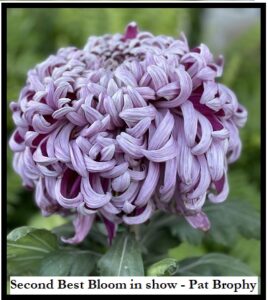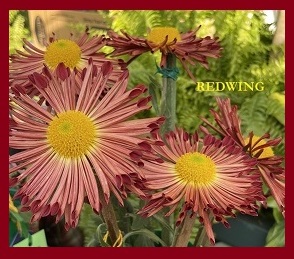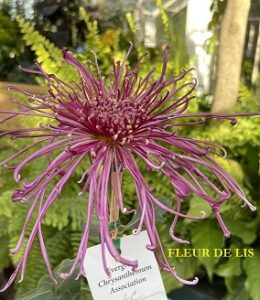EVERGREEN CHRYSANTHEMUM ASSOCIATION
Seattle, Washington
ECAMUMCLUB.ORG
Nancy Halleen, Secretary
HAPPY SPRING !
MEETING OF THE ECA – THURSDAY MAY 10th, 2012 at 7 PM at the Seattle Police Athletic Association Office (SPAA) site; 11030 East Marginal Way South, Tukwila.
At our May meeting, Chris Brookes will be making a presentation on “How computer projection can keep ECA members better informed.” “They” say a picture is worth a thousand words and Chris’ brief presentation will focus on images and information that is readily available to us: on the web, within the ECA computer library, and from member-created Power Point presentations.
Chris has already obtained some great images from our own members, plus assistance from the leading Mum growers in England (help provided by Ivor Mace, Andy Wickham and Paul Barlow) and it is really exciting to learn what we can do. After the presentation, we will need to vote on whether to go ahead and purchase projection equipment or not. Steve Backstrom has very kindly offered ECA the use of his son’s computer so we would only need to acquire a projector. A recommendation with associated costs will be provided.
PLANT SALE RESULTS
Congratulations to all who worked so hard growing plants for sale, setting up the event, and acted as a great sales team on April 13 and 14. We did very well on the 14th. Not quite to the record levels of 2011, but very much in line with earlier years. A great job Bob Ewing and everyone!
Plant Sale Saturday……………………..$1173.00
April meeting (Thursday)………………$ 338.00
There is more to come as some plants went to Portland and others to the Kitsap group.
NEW MEMBERS
Welcome to Margo Ashby, Tom Bennett, Cynthia Mason, and Loida Ramirez our clubs newest members who signed up during the April Plant Sale.
YEARBOOKS
The 2012 ECA Yearbooks will be at the May meeting. We will mail Yearbooks to members who do not attend the May meeting. Thanks to Mark Ross for again taking on this big project!
UPCOMING EVENTS
Mark your calendars for the following events:
Garden Tour/Potluck – August 12
Puyallup Fair – September 22nd (date to be verified)
USNCS Show and Convention in Portland – October 27 and 28, bloom prep. Oct. 26
Fall Show at Furney’s – November 2 – 4 (set up on Nov. 1)
Awards Banquet at Angelos– November 15
PLANT CULTURE and SUPPLIES –Cultural suggestions are attached for May and will be discussed at the meeting. Remember to contact Mark Ross for soilless and supplies as needed.
If we are mailing you the monthly notice and you have an email address, please send an email to Nancy Halleen with your email address.
TO DO LIST for May and June (revised DRS 4/25/05)
• Stopping:
Most plants are stopped April 15 through June 1, including the Early English classes. Keep your stop list handy and follow it rigorously. The calendar doesn’t move backwards. For #1 and #2 varieties the English literature recommends a fairly hard pinch; that is pinching 6-8 leafs down from the growing tip. For the incurves, #3, #13, #23 pinch the smallest portion of the growing tip to get more uniform growth of the laterals. For all varieties, fertilize 1-2 weeks before pinching to produce more laterals. This is especially true for the Fairweathers.
• Final Potting into 8”, 9” or 10” pots. (Or maybe in the garden soil)
Preparation
• Wash pots (in mild Clorox solution) then rinse in clear water.
• Prepare potting mix. – Soil fewer users; add another 5-10% of screened pumice or Perlite to improve drainage. Also at this final stage, I recommend adding Cedar Grove compost or other fresh compost and a small amount of well-composted horse manure. This results in a mix of 6 parts M&R soil less, 4 parts compost, 1 part pumice, and small amounts of horse manure and Alfalfa meal.Water plants in the 6” pots 1 day before repotting.
• Potting (Pot on when the ring of roots around the bottom of the pot is semi root bound.) Cover drain holes in bottom of clay pots with a piece of broken crock to keep drain clear. Put a layer of broken sod or course pumice in the bottom of pot, then cover with 1 or 2 inches of the final (9”) mix. Place the 6” root ball on top of the 9” mix and fill around with the 9” mix. The top of the root ball should be 1+ inch below the top of the pot. Do not pack the mix except as necessary to hold the plant and stake in place. Stake with shingle or bamboo stick.
• Add Marathon Systemic at this time to control black aphids. Sprinkle ½ tspn. Marathon on top of soil when repotting plant, add a thin layer of mix over the top, then water moderately.
• Note: When potting on occurs after June 1, Consider dropping down one pot size pot because the roots will not have time to fill the bigger pots. # 1 & #2 cultivars, 9” max, 8” could be used. #3s, 8” max.
• Feeding and pest management
• After 3 weeks in final pot start summer feeding program. ` 1 to 2 tsp. 20-10-20 per gallon water, once a week.
Note: Some plants will thrive with the heavier solution, while others
may not like so much fertilizer. Watch the leaves to gauge the fertilizer needed. If leaves become hard and curl up you are overfeeding. If leaves are somewhat weak and lighter green then more fertilizer would help. Miracle Grow is also used quite successfully by some during this summer stage.
• If plants are yellowish, first try drying them out. If drying the plant is unsuccessful, feed ½ tsp. Epsom Salts per plant. Leaf feeding of liquid iron such as Greenall or Sequesterine also helps green up the plant. Follow product directions. Do not over feed Liquid Iron.
• Review your pest management program every 2 weeks,
Marathon systemic is the most effective black aphid control.
Diazinon and most rose insecticides are somewhat less effective, and require spraying every 2 weeks, as they are contact insecticides. Spray every two weeks with a fungicide. Ortho Funginex is recommended. Other fungicides will work well if used regularly. If fungus gets away and is growing fast, a fungicide used to control early blight in tomatoes will really shut it down. I use Monterey “Bravo” for such control.
4. Lateral Control
As side laterals develop after the final pinch, select the number of laterals to carry through the summer and remove all other side shoots. Generally the topmost lateral below the stem break is removed, as it is the weakest lateral structurally and easily broken off by accident. At this early stage you should carry 1-2 more lateral than you want at the bloom stage. An old saying goes: “I grow 2 for me and one for the bug.”
Surplus laterals are removed later in the summer using the following guide.
For #1 & #2 cultivars, carry 2 or 3 laterals initially, cull to 1 or 2 in Aug.
For #3 cultivars, carry 5 laterals and cull Sept. or Oct.
For #4 & b#5 cultivars, carry 4 to 5 laterals and cull to 2 to 3 in Sept.
For Earliers (13-15 and 23-25) carry 4-5 laterals and cull to 2-3 in Sept.
For Spiders, Quills, Spoons, Singles etc. follow the guide for #4 and #5.
Note: Cutting back to the few laterals seems to be a most difficult task for the novice. You must do it however if you wish to get large blooms.
5. Staking.
By now all plants will require staking. A 16-24 in stake should be placed along the main plant stem and tied to it to support and protect the plant. As the side laterals develop it will be necessary to add longer stakes that can support each lateral all the way to bud development. Care must be exercised so as to not spread the new laterals too far apart when staking, as one or more could be broken off. In other words let the laterals grow till they can be easily tied to the new stakes.




